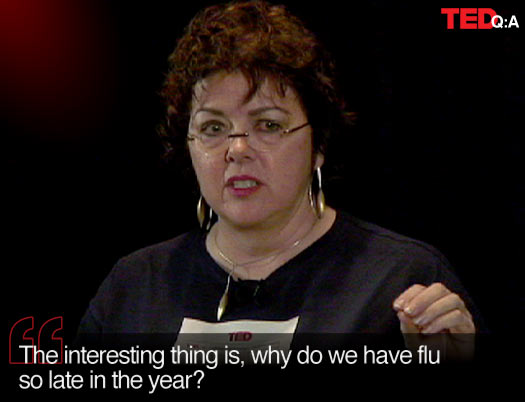
TED took 20 minutes with Laurie Garrett this afternoon to follow up on her TED Talk from 2007, posted today, about pandemic flu. Garrett is the author of The Coming Plague, and a fellow on the Council for Foreign Relations who studied global health and emerging diseases. (As you can imagine, she is very busy this week, amid news of the spreading H1N1 virus.) We asked Garrett: What has changed since the last pandemic panic, 2007’s avian flu? What does she worry about now? And really, should we not wash our hands?
Did the avian flu scare of two years ago prompt real action from the government?
Yeah, I think actually there’s been a serious maturation in not only US response but all over the world and within the WHO. We’re in a different era in terms of how the public is getting information. The CDC even has a Twitter account — hundreds of thousands of people are twittering the CDC.
So the situation of 2007 has changed?
Yes, we’re way beyond that now. All the thought processes that went on, all the practices and drills — and criticisms from people like myself — has paid off.
The WHO seems much more open now — with daily briefings on the web, news releases, the announcement today that we’re not longer calling it “swine flu” …
That was because the pork industry went bananas. They’ve seen countries ban US and Mexican pork products. It’s affecting the US meat industry in ways that couldn’t be predicted. It’s what we saw in the chicken industry with H5N1 [avian flu].
But it’s really important to understand — in the big picture, stepping away from the immediate situation — it’s not coincidental that we’re looking at a virus that seems to have elements genetically from at least three species of host, human, bird and pig, and even the pig pieces seem to come from a minimum of six different input points. This is the most deeply mosaiced virus that we’ve seen circulating in humans. And it has erupted from the pork industry. So we have these giant industrial-scaled pork plants where the pigs are literally snout to snout — you have an infection start at one end, and it just zips through the whole darn place.
One of our Facebook commenters noted this — that “packing 500,000 animals in a space of the size of a football field is a recipe for disaster.”
Pigs are passing their viruses to humans, but more significantly, humans are passing their viruses to pigs. H1N1 appears to have been a human virus that passed through pigs, through birds, back through pigs, it took a few more turns, and then back to humans.
We have these new ecologies that are complete artificial and completely bizarre. Imagine a row of neatly stacked dominoes all stacked in the same way. Think of the pork industry as the dominoes. You’re creating these perfect environments for disease. We know it’s better to have a heterogeneous population, and this is a huge wake-up call.
Do you feel differently now than you did then about any of the points you made — about masks or handwashing, for instance?
I think the primary purpose of a mask is to scare the heck out of the people you’re talking to, and then they stay 5 feet away. They don’t keep viruses away, they keep people away.
For those who are health professionals and first responders, who have to get up close and personal with people, I remain convinced that only an N95 mask, a fitted N95 mask, offers the proper protection.
For the average person, I really think the primary person of the mask is to scare other people. Although, if you are sick and you cough, most of the droplets do end up inside the mask, so you are protecting other people.
And handwashing?
Well, I think handwashing is going to help. You should wash your hands.
But the interesting thing is, Why do we have flu so late in the year? Usually the flu season has been over for quite some time, so this is a very unusual situation. And one of the things that’s interesting about why flu is seasonal, and is the sort of bad-news endpoint of the paragraph I am now uttering: When flu is coughed or you sneeze it, the virus is suspended in a liquid environment. Ideally an environment with lots of polysaccharides and sugars, an environment like mucus. Suspended in mucus, the virus can go from your hand to a doorknob, from a doorknob to another person’s hand; it can go onto the surface of a telephone … all those things are contagious to others. Mucus also protects the virus from ultraviolet rays.
One reason flu is seasonal — as the temperature rises, these things tend to dry out. So in the summer, it’s very, very unusual to see flu virus circulating. The bad new is, if this virus has indeed taken hold, it will move to the Southern hemisphere for their winter, and it will come back to us, possibly in a different mutation, this fall. As our temperatures drop, we may see a return. This is the ominous issue.
Comments (6)
Pingback: How to print meat and leather: Andras Forgacs at TEDGlobal 2013 | Krantenkoppen Tech